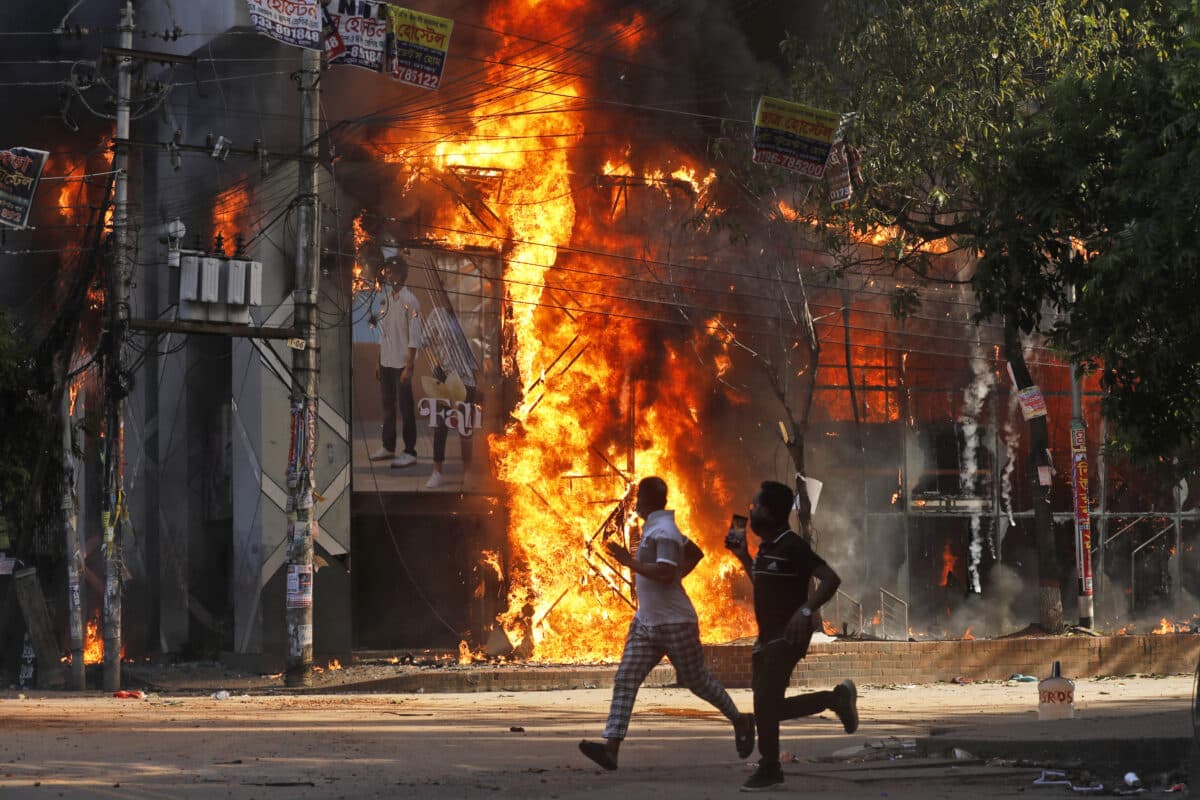Bangladesh PM flees country after deadly protests

Men run past a shopping center which was set on fire by protesters during a rally against Prime Minister Sheikh Hasina and her government demanding justice for the victims killed in the recent countrywide deadly clashes, in Dhaka, Bangladesh, Sunday, Aug. 4, 2024. (Associated Press Photo/Rajib Dhar)
DHAKA, Bangladesh — Bangladeshi Prime Minister Sheikh Hasina fled the country on Monday, a source close to the leader told AFP, following more than a month of deadly anti-government protests.
Hasina, who has ruled since 2009, had defied weeks of demands for her to stand down but fled following a brutal day of unrest on Sunday in which nearly 100 people died.
Hasina, 76, fled the country by helicopter, a source close to the leader told AFP shortly after protesters had stormed her palace in Dhaka.
“Her security team asked her to leave, she did not find any time to prepare”, the source said.
The source added she left first by motorcade but then was flown out, without saying her destination. “She was later evacuated on a helicopter.”
Article continues after this advertisementJubilant-looking crowds had waved flags, some dancing on top of a tank in the streets on Monday morning before hundreds broke through the gates of Hasina’s official residence.
Article continues after this advertisementBangladesh’s Channel 24 broadcast images of crowds running into the compound, waving to the camera as they celebrated.
Others smashed a statue of Hasina’s father Sheikh Mujibur Rahma, the country’s independence hero.
Bangladesh’s army chief Waker-Uz-Zaman would address the nation on Monday afternoon, a military spokesman told AFP without giving further details.
Before the protesters had stormed the compound, Hasina’s son urged the country’s security forces to block any takeover from her 15-year rule.
“Your duty is to keep our people safe and our country safe and to uphold the constitution,” her son, US-based Sajeeb Wazed Joy, said in a post on Facebook.
“It means don’t allow any unelected government to come in power for one minute, it is your duty.”
Security forces had supported Hasina’s government throughout the unrest, which began last month against civil service job quotas and then escalated into wider calls for her to stand down.
But the protesters defied curfews and deadly force.
At least 94 people were killed on Sunday, including 14 police officers, in the deadliest day of the unrest.
Protesters and government supporters countrywide battled each other with sticks and knives, and security forces opened fire.
The day’s violence took the total number of people killed since protests began in early July to at least 300, according to an AFP tally based on police, government officials, and doctors at hospitals.
Waker told officers on Saturday that the military “always stood by the people”, according to an official statement.
The military declared an emergency in January 2007 after widespread political unrest and installed a military-backed caretaker government for two years.
‘Final protest’
Hasina has ruled Bangladesh since 2009 and won her fourth consecutive election in January after a vote without genuine opposition.
Her government is accused by rights groups of misusing state institutions to entrench its hold on power and stamp out dissent, including through the extrajudicial killing of opposition activists.
Demonstrations began over the reintroduction of a quota scheme that reserved more than half of all government jobs for certain groups.
The protests escalated despite the scheme having been scaled back by Bangladesh’s top court.
Soldiers and police with armored vehicles in Dhaka had barricaded routes to Hasina’s office with barbed wire on Monday morning, but vast crowds flooded the streets, tearing down barriers.
The Business Standard newspaper estimated as many as 400,000 protesters were on the streets but it was impossible to verify the figure.
“The time has come for the final protest,” said Asif Mahmud, one of the key leaders in the nationwide civil disobedience campaign.
In several cases, soldiers and police did not intervene to stem Sunday’s protests, unlike during the past month of rallies that repeatedly ended in deadly crackdowns.
“Let’s be clear: The walls are closing in on Hasina: She’s rapidly losing support and legitimacy,” Michael Kugelman, director of the South Asia Institute at the Washington-based Wilson Center, told AFP.
“The protests have taken on immense momentum, fuelled by raw anger but also by the confidence that comes with knowing that so much of the nation is behind them,” he said.
In a hugely symbolic rebuke of Hasina, a respected former army chief demanded the government “immediately” withdraw troops and allow protests.
“Those who are responsible for pushing people of this country to a state of such extreme misery will have to be brought to justice,” ex-army chief General Ikbal Karim Bhuiyan told reporters Sunday.
The anti-government movement attracted people from across society in the South Asian nation of about 170 million people, including film stars, musicians, and singers.